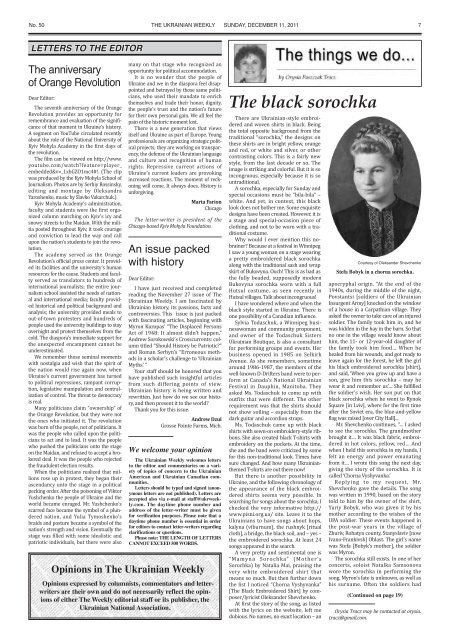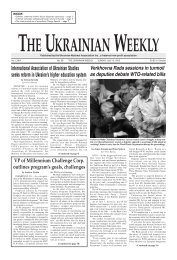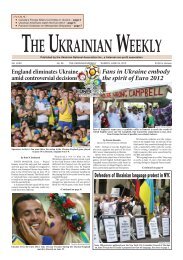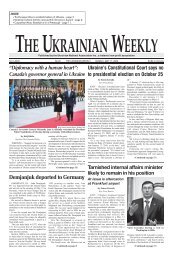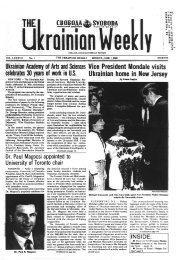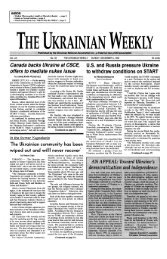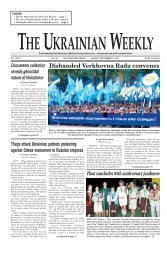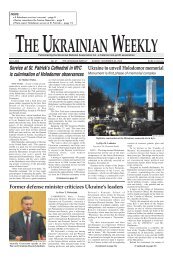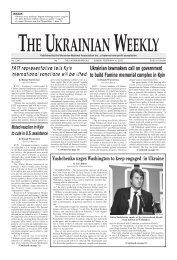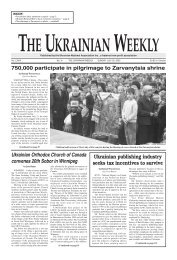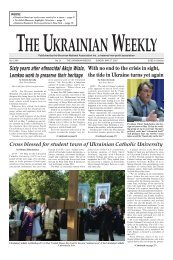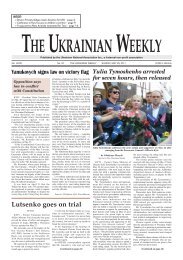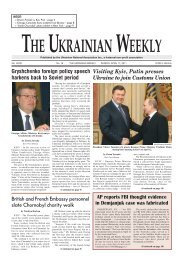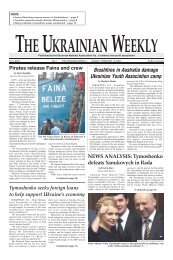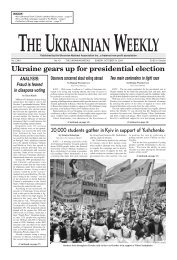Tymoshenko supporters block Rada presidium - The Ukrainian Weekly
Tymoshenko supporters block Rada presidium - The Ukrainian Weekly
Tymoshenko supporters block Rada presidium - The Ukrainian Weekly
You also want an ePaper? Increase the reach of your titles
YUMPU automatically turns print PDFs into web optimized ePapers that Google loves.
No. 50<br />
THE UKRAINIAN WEEKLY SUNDAY, DECEMBER 11, 2011<br />
7<br />
LETTERS TO THE EDITOR<br />
<strong>The</strong> anniversary<br />
of Orange Revolution<br />
Dear Editor:<br />
<strong>The</strong> seventh anniversary of the Orange<br />
Revolution provides an opportunity for<br />
remembrance and evaluation of the significance<br />
of that moment in Ukraine’s history.<br />
A segment on YouTube circulated recently<br />
about the role of the National University of<br />
Kyiv Mohyla Academy in the first days of<br />
the revolution.<br />
<strong>The</strong> film can be viewed on http://www.<br />
youtube.com/watch?feature=player_<br />
embedded&v=_1xbGZO1mc4#!. (<strong>The</strong> clip<br />
was produced by the Kyiv Mohyla School of<br />
Journalism. Photos are by Serhiy Rossinsky,<br />
editing and montage by Oleksandra<br />
Yaroshenko, music by Slavko Vakarchuk.)<br />
Kyiv Mohyla Academy’s administration,<br />
faculty and students were the first organized<br />
column marching on Kyiv’s icy and<br />
snowy streets to the Maidan. With the militia<br />
posted throughout Kyiv, it took courage<br />
and conviction to lead the way and call<br />
upon the nation’s students to join the revolution.<br />
<strong>The</strong> academy served as the Orange<br />
Revolution’s official press center. It provided<br />
its facilities and the university’s human<br />
resources for the cause. Students and faculty<br />
served as translators to hundreds of<br />
international journalists; the entire journalism<br />
school assisted the needs of national<br />
and international media; faculty provided<br />
historical and political background and<br />
analysis; the university provided meals to<br />
out-of-town protesters and hundreds of<br />
people used the university buildings to stay<br />
overnight and protect themselves from the<br />
cold. <strong>The</strong> diaspora’s immediate support for<br />
the unexpected encampment cannot be<br />
underestimated.<br />
We remember those seminal moments<br />
with nostalgia and wish that the spirit of<br />
the nation would rise again now, when<br />
Ukraine’s current government has turned<br />
to political repressions, rampant corruption,<br />
legislative manipulation and centralization<br />
of control. <strong>The</strong> threat to democracy<br />
is real.<br />
Many politicians claim “ownership” of<br />
the Orange Revolution, but they were not<br />
the ones who initiated it. <strong>The</strong> revolution<br />
was born of the people, not of politicians. It<br />
was the people who called upon the politicians<br />
to act and to lead. It was the people<br />
who pushed the politicians onto the stage<br />
on the Maidan, and refused to accept a brokered<br />
deal. It was the people who rejected<br />
the fraudulent election results.<br />
When the politicians realized that millions<br />
rose up in protest, they began their<br />
ascendancy unto the stage in a political<br />
pecking order. After the poisoning of Viktor<br />
Yushchenko the people of Ukraine and the<br />
world became enraged. Mr. Yushchenko’s<br />
scarred face became the symbol of a plundered<br />
nation, and Yulia <strong>Tymoshenko</strong>’s<br />
braids and posture became a symbol of the<br />
nation’s strength and vision. Eventually the<br />
stage was filled with some idealistic and<br />
patriotic individuals, but there were also<br />
many on that stage who recognized an<br />
opportunity for political accommodation.<br />
It is no wonder that the people of<br />
Ukraine and we in the diaspora feel disappointed<br />
and betrayed by those same politicians,<br />
who used their mandate to enrich<br />
themselves and trade their honor, dignity,<br />
the people’s trust and the nation’s future<br />
for their own personal gain. We all feel the<br />
pain of the historic moment lost.<br />
<strong>The</strong>re is a new generation that views<br />
itself and Ukraine as part of Europe. Young<br />
professionals are organizing strategic political<br />
projects; they are working on transparency,<br />
the defense of the <strong>Ukrainian</strong> language<br />
and culture and recognition of human<br />
rights. Repressive current actions of<br />
Ukraine’s current leaders are provoking<br />
increased reactions. <strong>The</strong> moment of reckoning<br />
will come. It always does. History is<br />
unforgiving.<br />
Opinions in <strong>The</strong> <strong>Ukrainian</strong> <strong>Weekly</strong><br />
Marta Farion<br />
Chicago<br />
<strong>The</strong> letter-writer is president of the<br />
Chicago-based Kyiv Mohyla Foundation.<br />
An issue packed<br />
with history<br />
Dear Editor:<br />
I have just received and completed<br />
reading the November 27 issue of <strong>The</strong><br />
<strong>Ukrainian</strong> <strong>Weekly</strong>. I am fascinated by<br />
<strong>Ukrainian</strong> history, its passions, facts and<br />
controversies. This issue is just packed<br />
with fascinating articles, beginning with<br />
Myron Kuropas’ “<strong>The</strong> Displaced Persons<br />
Act of 1948: It almost didn’t happen,”<br />
Andrew Sorokowski’s Crosscurrents: column<br />
titled “Should History be Patriotic?”<br />
and Roman Serbyn’s “Erroneous methods<br />
in a scholar’s challenge to ‘<strong>Ukrainian</strong><br />
Myths.’ ”<br />
Your staff should be honored that you<br />
have published such insightful articles<br />
from such differing points of view.<br />
<strong>Ukrainian</strong> history is being written and<br />
rewritten. Just how do we see our history,<br />
and then present it to the world?<br />
Thank you for this issue.<br />
Andrew Dzul<br />
Grosse Pointe Farms, Mich.<br />
We welcome your opinion<br />
<strong>The</strong> <strong>Ukrainian</strong> <strong>Weekly</strong> welcomes letters<br />
to the editor and commentaries on a variety<br />
of topics of concern to the <strong>Ukrainian</strong><br />
American and <strong>Ukrainian</strong> Canadian communities.<br />
Letters should be typed and signed (anonymous<br />
letters are not published). Letters are<br />
accepted also via e-mail at staff@ukrweekly.com.<br />
<strong>The</strong> daytime phone number and<br />
address of the letter-writer must be given<br />
for verification purposes. Please note that a<br />
daytime phone number is essential in order<br />
for editors to contact letter-writers regarding<br />
clarifications or questions.<br />
Please note: THE LENGTH OF LETTERS<br />
CANNOT EXCEED 500 WORDS.<br />
Opinions expressed by columnists, commentators and letterwriters<br />
are their own and do not necessarily reflect the opinions<br />
of either <strong>The</strong> <strong>Weekly</strong> editorial staff or its publisher, the<br />
<strong>Ukrainian</strong> National Association.<br />
<strong>The</strong> things we do ...<br />
by Orysia Paszczak Tracz<br />
<strong>The</strong> black sorochka<br />
<strong>The</strong>re are <strong>Ukrainian</strong>-style embroidered<br />
and woven shirts in black. Being<br />
the total opposite background from the<br />
traditional “sorochka,” the designs on<br />
these shirts are in bright yellow, orange<br />
and red, or white and silver, or other<br />
contrasting colors. This is a fairly new<br />
style, from the last decade or so. <strong>The</strong><br />
image is striking and colorful. But it is so<br />
incongruous, especially because it is so<br />
untraditional.<br />
A sorochka, especially for Sunday and<br />
special occasions must be “bila-bila” –<br />
white. And yet, in context, this black<br />
look does not bother me. Some exquisite<br />
designs have been created. However, it is<br />
a stage and special-occasion piece of<br />
clothing, and not to be worn with a traditional<br />
costume.<br />
Why would I ever mention this nobrainer?<br />
Because at a festival in Winnipeg<br />
I saw a young woman on a stage wearing<br />
a pretty embroidered black sorochka<br />
along with the traditional sash and wrap<br />
skirt of Bukovyna. Ouch! This is as bad as<br />
the fully beaded, supposedly modern<br />
Bukovyna sorochka worn with a full<br />
Hutsul costume, as seen recently in<br />
Hutsul villages. Talk about incongruous!<br />
I have wondered where and when the<br />
black style started in Ukraine. <strong>The</strong>re is<br />
one possibility of a Canadian influence.<br />
Sylvia Todaschuk, a Winnipeg businesswoman<br />
and community proponent,<br />
and owner of the Todaschuk Sisters<br />
<strong>Ukrainian</strong> Boutique, is also a consultant<br />
for performing groups and events. Her<br />
business opened in 1985 on Selkirk<br />
Avenue. As she remembers, sometime<br />
around 1986-1987, the members of the<br />
well-known D-Drifters band were to perform<br />
at Canada’s National <strong>Ukrainian</strong><br />
Festival in Dauphin, Manitoba. <strong>The</strong>y<br />
asked Ms. Todaschuk to come up with<br />
outfits that were different. <strong>The</strong> other<br />
requirement was that the shirts should<br />
not show soiling – especially from the<br />
dark guitar and accordion straps.<br />
Ms. Todaschuk came up with black<br />
shirts with sewn-on embroidery-style ribbons.<br />
She also created black T-shirts with<br />
embroidery on the pockets. At the time,<br />
she and the band were criticized by some<br />
for this non-traditional look. Times have<br />
sure changed. And how many <strong>Ukrainian</strong>themed<br />
T-shirts are out there now!<br />
But there is another possibility in<br />
Ukraine, and the following chronology of<br />
the appearance of the black embroidered<br />
shirts seems very possible. In<br />
searching for songs about the sorochka, I<br />
checked the very informative http://<br />
www.pisni.org.ua/ site. Leave it to the<br />
<strong>Ukrainian</strong>s to have songs about hops,<br />
kalyna (viburnum), the rushnyk [ritual<br />
cloth], a bridge, the black soil, and – yes –<br />
the embroidered sorochka. At least 24<br />
songs appeared in the search.<br />
A very pretty and sentimental one is<br />
“ M a myna Sorochka” (Mother’s<br />
Sorochka) by Natalia Mai, praising the<br />
very white embroidered shirt that<br />
means so much. But then further down<br />
the list I noticed “Chorna Vyshyvanka”<br />
[<strong>The</strong> Black Embroidered Shirt] by composer/lyricist<br />
Oleksander Shevchenko.<br />
At first the story of the song, as listed<br />
with the lyrics on the website, left me<br />
dubious. No names, no exact location – an<br />
Courtesy of Oleksander Shevchenko<br />
Stefa Bobyk in a chorna sorochka.<br />
apocryphal origin. “At the end of the<br />
1940s, during the middle of the night,<br />
Povstantsi [soldiers of the <strong>Ukrainian</strong><br />
Insurgent Army] knocked on the window<br />
of a house in a Carpathian village. <strong>The</strong>y<br />
asked the owner to take care of an injured<br />
soldier. <strong>The</strong> family took him in, and he<br />
was hidden in the hay in the barn. So that<br />
no one in the village would know about<br />
him, the 11- or 12-year-old daughter of<br />
the family took him food… When he<br />
healed from his wounds, and got ready to<br />
leave again for the forest, he left the girl<br />
his black embroidered sorochka [shirt],<br />
and said, ‘When you grow up and have a<br />
son, give him this sorochka – may he<br />
wear it and remember us’… She fulfilled<br />
the soldier’s wish. Her son put on that<br />
black sorochka when he went to Rynok<br />
Square [in Lviv], where for the first time<br />
after the Soviet era, the blue-and-yellow<br />
flag was raised [over City Hall]...<br />
Mr. Shevchenko continues, “… I asked<br />
to see the sorochka. <strong>The</strong> grandmother<br />
brought it… It was black fabric, embroidered<br />
in hot colors, yellow, red… And<br />
when I held this sorochka in my hands, I<br />
felt an energy and power emanating<br />
from it… I wrote this song the next day,<br />
giving the story of the sorochka. It is<br />
called ‘Chorna Vyshyvanka.’<br />
Replying to my request , Mr.<br />
Shevchenko gave the details. <strong>The</strong> song<br />
was written in 1990, based on the story<br />
told to him by the owner of the shirt,<br />
Yuriy Bobyk, who was given it by his<br />
mother according to the wishes of the<br />
UPA soldier. <strong>The</strong>se events happened in<br />
the post-war years in the village of<br />
Zhuriv, Rohatyn county, Stanyslaviv [now<br />
Ivano-Frankivsk] Oblast. <strong>The</strong> girl’s name<br />
was Stefa [Bobyk’s mother], the soldier<br />
was Myron.<br />
<strong>The</strong> sorochka still exists. In one of her<br />
concerts, soloist Natalka Samsonova<br />
wore the sorochka in performing the<br />
song. Myron’s fate is unknown, as well as<br />
his surname. Often the soldiers had<br />
(Continued on page 19)<br />
Orysia Tracz may be contacted at orysia.<br />
tracz@gmail.com.


